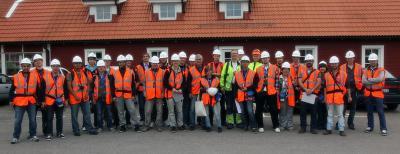Two NPRE graduate students traveled to Sweden in June to learn how that country is working toward a final solution for storing spent nuclear fuel.

NPRE students Rabie Abdullah Abu Saleem and Kuan-Che Lan (from left) tour the Äspö Hard Rock Laboratory in Sweden.
As part of the experience, students Rabie Abdullah Abu Saleem and Kuan-Che Lan toured the Äspö Hard Rock Laboratory, a unique geological disposal research facility near Oskarshamn, where experiments are performed 500 meters underground. There, the Swedish Nuclear Fuel and Waste Management Company (SKB) rehearses procedures for the final Spent Fuel Repository planned for construction in Forsmark, north of Oskarshamn on Sweden’s eastern coast line.
The plan is for spent fuel to be stored in copper canisters placed deep in underground tunnels for 100,000 years until the radioactivity decays. The repository must fulfill the authorities’ long-term safety requirements, which can be converted into an average dose for human beings of about one per cent of the natural background radiation. Construction on the cutting-edge site could begin in 2016 and the site should be inaugurated in 2022 or 2024.
Locating the most desirable site for the storage facility in the country’s Precambrian geological formations has been a 20-year process. Abu Saleem and Lan, along with students from four other universities around the world, gained knowledge on how the site decision was made. The participants developed and presented maps of rock and soil types, conducted tectonic mapping, examined hydrogeology, and considered factors that would affect groundwater chemistry.
“We would measure the direction and orientation of cracks in rocks, “Abu Saleem said. “They were teaching us how to make evaluations.”
“The fewer number of fractures the better for the site because there would be less chance for a leak to groundwater,” Lan explained.
The students also considered historical climatic influences to determine how that would affect rock formations over an extended period of time. Furthermore, they learned about the social and political aspects involved in Sweden’s nuclear power policies.
Lan said the majority of the country’s citizens are confident of the safety of nuclear power currently, and Forsmark and Oskarshamn competed for the final repository site. Protests did arise 20 years ago, but nuclear power proponents went into the communities to make their case.
“You have to be very patient to communicate to the people,” Lan said.
SKB joined with Swedish universities Linneaus University and Royal Institute of Technology and the Nova Center for University Studies Research and Development to offer the summer program for students including Abu Saleem and Lan. Participants also came from the University of Houston – Downtown; the AGH University of Science and Technology in Poland; the Warsaw University of Technology in Poland; and the Moscow Engineering Physical Institute in Russia.
Lan and Abu Saleem are both students of NPRE Assistant Prof. Tomasz Kozlowski. Lan is studying stability of boiling water reactors, while Abu Saleem is interested in two-phase flow simulations.